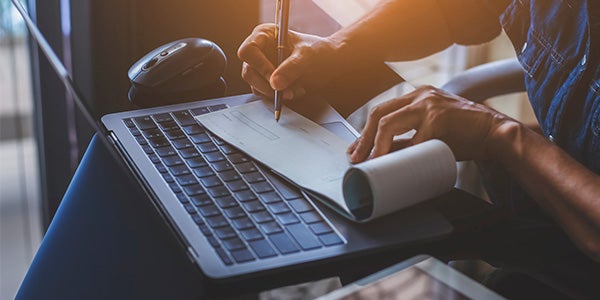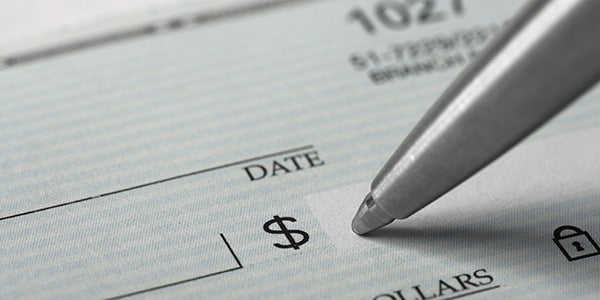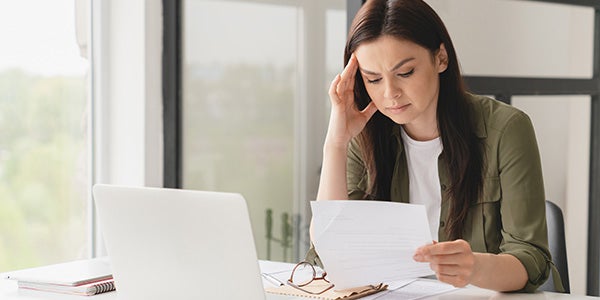Don’t let fraud prevention fall by the wayside. To survive in a world full of scammers and thieves, small businesses must take cybersecurity and check fraud seriously. Never trust a suspicious check, and don’t hesitate to request an alternative payment. Utilizing check payments to pay your vendors may also be putting your business at risk. Learn more about check fraud and how to protect your business.
Bank checks are still the most popular method for making business-to-business payments. But unfortunately, check fraud has significantly increased over the last several years. According to the Association for Financial Professionals, 63% of organizations experienced check fraud in 2022. Even worse, 500,000 people already fall victim to check fraud scams each year. The notable uptick in fraud begs the question: are checks still safe? Without the proper tools, your company could be susceptible to fraud.
Ask yourself: do you regularly accept checks? Do you regularly write checks to pay business expenses? Let’s unpack seven things you need to know about fraud—and whether it’s safe to continue to use and accept checks.
1. What Does Check Fraud Entail?
Any effort to obtain money illegally using paper or digital checks constitutes check fraud. This may include forging a check with someone else’s name, writing a bad check from your account or drawing up an entirely fake check.

These scams work because fake checks (mostly) look like real checks. If they’re good enough to fool bank employees, you can assume they're good enough to trick you and your staff.
Fake checks typically bear the name and addresses of legitimate banks and financial institutions, giving them an air of legitimacy. And sometimes, they’re real checks obtained by stealing somebody’s identity—which is why many wonder if checks are safe anymore.
You’ll see that the check has “cleared” once the funds land in your account—but that doesn’t mean it was a good check. According to the FTC, it can take weeks for forgeries and bad checks to be noticed. By then, the scammer is long gone—likely having spent whatever money you sent them.
Do you still think checks are safe for your business? Let’s dive deeper into check fraud and how intricate these malicious actors get with their schemes.
2. How Many Types of Check Fraud Are There?
Check fraud can be as simple as writing a bad check, forging someone’s name or drafting a fake check from scratch. But scammers know it takes ingenuity and careful planning to get away with their crimes.

They’ll go to great lengths to make their fake or bad checks seem safe. Some techniques include:
- Forgery: When an employee issues a business check without authorization or when someone endorses a stolen check and attempts to cash it.
- Paper Hanging: When scammers write and reorder checks on a closed account (either their own or someone else's).
- Check Kiting/Floating: Where the fraudster takes advantage of float (when duplicate funds exist between the deposited and drawn accounts). They’ll deposit and draw checks between two or more banks to falsely inflate the balance in one account.
- Alteration: When fraudsters use chemicals to alter or erase pen ink on a check (and then write in their names or a different amount).
- Counterfeiting: When scammers use editing software to make fake checks or duplicate checks with photocopiers.
Business leaders must be aware of the countless ways they could fall victim to check fraud. One way that scammers target small business owners is using the overpayment scam. Someone will buy something from your online store and “accidentally” send a check for too much money—perhaps several hundred dollars more than what they owed. They ask you to refund the balance, taking the extra cash and leaving you with a worthless check.
3. Is a Cashier’s Check Scam Any Different?
Cashier’s checks are like the debit cards of the check world. They have a near-instant turnaround time since the bank guarantees them. When you order a cashier’s check, you must either pay the total amount up front in cash or have it readily available in your checking account for instant withdrawal. The up-front payment means the cashier's checks can’t bounce—if they’re real.
Because cashier’s checks are considered safe, scammers use them to fool their most vigilant victims. A typical cashier’s check scam may play out like so:
Let’s say you own a landscaping business. A scammer messages you, claiming they’re interested in yard cleanup for one of their rental properties. You provide an invoice for $500. However, they insist on sending you a cashier's check for $900, claiming they made a mistake at the bank.
They kindly ask you to send the extra cash and you do, assuming the cashier’s check is real. Then, weeks later, your bank notifies you of the scam. Now you're left on the hook to repay the bank.

According to the Connecticut Department of Banking, cashier’s check fraud has become more prevalent in recent years. Scammers rely on peoples’ inherent trust in these so-called safe checks, knowing the bank won’t detect their fraud until they’re long gone.
Caution is of the utmost importance, even with cashier’s checks. Never wire money or provide goods and services until after the check has cleared through your bank.
4. What Are the Signs of a Fraudulent Check?
Small business owners don’t have to wait for their bank to confirm a check’s authenticity. There are ways to verify checks before depositing them—which is the wise thing to do if you have any doubts.
When dealing with large amounts, you must ensure checks’ validity and that the sender has sufficient funds. Let’s explore some signs and red flags you should watch for when determining if checks are safe:
Consider the Sender
First and foremost, ask who’s sending you this check. Have you done business with this person before? Do they have a habit of bouncing checks? Did someone contact you randomly, offering to send a check in exchange for goods and services? If so, they might be trying to scam you.

Verify the Funds
If you’re sitting on a suspicious check, you can always contact the bank from which the check was drawn to verify the funds. They can tell you whether there’s enough money to cash the check (at that moment). If there is, and you know the check is good, deposit it immediately—as the account holder could withdraw funds later.
Some banks may only tell you if the account is valid for privacy reasons. Others might not tell you anything at all.
Spot the Fakes
You may still hold a fake check even if you verify the funds. Before depositing:
- Ensure the issuing bank is legitimate. Double-check the address and bank number written on the check (if included).
- Look for unique security features. These include microprinting on the signature line and the words “original document” on the rear of the check.
- Double-check the amount. Scammers like to “overpay” before asking you to refund the amount.
- Look for smudges or discoloration, telltale signs that someone altered the check somehow.
- Check for inconsistent handwriting.
Remember, if you have any doubts, ask for another form of payment. Never accept a suspicious check.
5. Who Pays for Check Fraud?
It can take the bank weeks to uncover a fake check once deposited. In that time, you’ve likely spent the money, rightfully assuming it was yours to spend. Then, once the check bounces, your bank will come looking for its money. The scammer is long gone—and you’re left holding the bag.

For small business owners, getting stuck paying the bank can be catastrophic. If someone paid for your goods and services with a bad check, they robbed you of whatever you sell. Now, you’re out the money you owe to the bank and whatever inventory they stole.
Sadly, the buck doesn’t stop there. Aside from repaying the total amount:
- You might have to pay overdraft fees if the bank debits your account to make up for the bad check, thus overdrafting.
- The bank could freeze/close your account, something you can’t afford when running a small business.
- You could damage your credit if the check bounces and you can’t pay your bills. Furthermore, you’ll accrue late fees for unpaid bills.
Building a strong relationship with your business bank is crucial to fraud prevention. If something does happen, your representative can connect you with the proper departments and authorities.
6. How Can You Protect Your Small Business from Check Fraud?
According to Bloomberg, we’re experiencing a severe mail theft problem. More specifically, criminals steal checks from people’s mailboxes and sell them on the black market. Some will even steal a postal worker’s keys and sell them online for upwards of $7,000.
The best way to avoid mail theft and keep your money safe is rather simple—don’t send checks through the mail. Lean on digital transactions instead to ensure your money goes where intended.

Checks are highly susceptible to fraud, exemplifying the need for safer non-cash payment systems like automated clearing house (ACH), business credit cards, Check Positive Pay and ACH Positive Pay.
All four stop fraudulent payments before they hit your account. Let’s dive into why they’re faster, safer, and more reliable than sending B2B checks:
Automated Clearing House (ACH)
An ACH is a digital service that allows small businesses (and regular people) to transfer money between bank accounts. You likely use one daily—whether issuing employee paychecks via direct deposit, paying a utility bill through an online portal or sending money over Venmo or Zelle.
Business Credit Cards
If your small business doesn’t accept credit card payments, you’re likely leaving money on the table. Credit cards are a safe way to settle your vendor debts and collect payments. Credit cards also provide more cash flow security than ACH, as the funds take less time to clear.
Check Positive Pay
Check Positive Pay acts as a checks-and-balances system to help protect against fraud. The service offered through your financial institution compares the dollar amount, check number, and account number of each check presented against a list provided by your company. Your bank won’t clear the check if something doesn't add up. Instead, they’ll return it for reexamination.
ACH Positive Pay
If you rely on an ACH to make and receive payments, ACH Positive Pay allows you to create filters on your business account to only allow certain debits to process uninterrupted. Otherwise, it’ll block all ACH debits to your business account.
Protect Your Business Finances Today
Don’t let fraud prevention fall by the wayside. To survive in a world full of scammers and thieves, small businesses must take cybersecurity and check fraud seriously. Never trust a suspicious check, and don’t hesitate to request an alternative payment. Remember—if you end up cashing a bad check, you’ll be on the hook to pay the bank.
Navigating a fraud-filled business world can be overwhelming, but you don’t have to do it alone. Small business owners can lean on trusted financial partners like Wisconsin Bank & Trust, a division of HTLF Bank to help protect their business from check fraud and other financial scams.
Get in touch with Wisconsin Bank & Trust, a division of HTLF Bank today to speak with a commercial banker with deep industry insight. Together, you can move away from writing checks and toward safer digital payment options.

